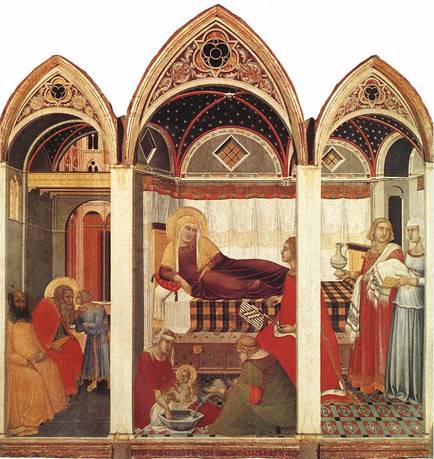 The Nativity of the Virgin is a painting by the Italian painter, Pietro Lorenzetti. It was done around 1335-1342. The painting had been commissioned as part of a cycle of four altarpieces dedicated to the city's patron saints and originally was a secondary altarpiece in the Cathedral of Siena. The painting utilizes linear perspective as the work is separated by two white piers in the foreground and there is a three-dimensio
The Nativity of the Virgin is a painting by the Italian painter, Pietro Lorenzetti. It was done around 1335-1342. The painting had been commissioned as part of a cycle of four altarpieces dedicated to the city's patron saints and originally was a secondary altarpiece in the Cathedral of Siena. The painting utilizes linear perspective as the work is separated by two white piers in the foreground and there is a three-dimensionality to the living area depicted. The painting is indicative of the Renaissance as the characters, their clothes and surroundings, all have the realism characteristic of the period.
The work is a triptych with the scenes set in the same location. The left scene depicts Mary's father, Joachim, almost being told the birth of the Virgin Mary has occurred outside of the room where the birth occurred and therefore, somewhat removed from the experience. The most interesting feature of this fresco is the two panels to the right. Birthing in Renaissance Italy was a community affair with many women and a midwife helping the pregnant wife through. In Lorenzetti's painting, the community affair of Renaissance childbirth is evident. A woman in red, maybe a midwife, is seen washing the newly born Virgin Mary; women stand, in the rightmost panel, with cloth, waiting to help the resting mother and baby. In total, there are 5 women in the room with the mother during the birth and this would have been pretty standard for the period. The painting shows a Renaissance touch to the old subject of the nativity of Mary.
The painting is now housed in the Museo dell'Opera del Duomo of Siena, Italy.
Credits:
https://www.khanacademy.org/humanities/renaissance-reformation/late-gothic-italy/siena-late-gothic/v/pietro-lorenzetti-birth-of-the-virgin-c-1342
https://en.wikipedia.org/wiki/Nativity_of_the_Virgin_(Pietro_Lorenzetti)
Image:
https://upload.wikimedia.org/wikipedia/commons/c/c7/Pietro_lorenzetti,_natività_della_vergine_del_duomo_di_siena,_1342,_tempera_su_tavola_187x182,_museo_dell'opera_del_duomo_di_siena.jpg
Great checked bedspread, and nice use of class terms.
ReplyDeleteBella,
ReplyDeleteI really enjoyed reading your post. The work is quite beautiful. I love the fra
ming devices surrounding the three panels, it shows great detail! This is a very interesting subject matter, one that I have not seen before. It is obvious that the role of the midwife was extremely important at the time. Beautiful!
Good job!